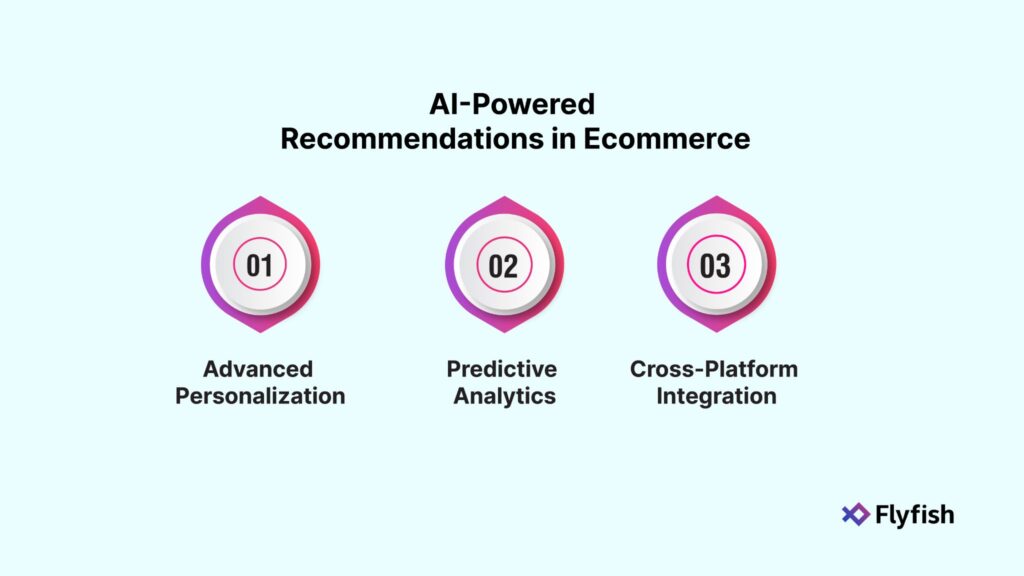
Introduction
How often have you browsed through countless products online, only to end up confused and frustrated, unsure of which one to pick? This is where AI-driven recommendation systems can make all the difference, acting like a personal shopping assistant guiding you to that perfect product.
Recent study has revealed that companies implementing AI in ecommerce have seen up to a 20% increase in conversion rates. These systems analyze your preferences and behavior to deliver relevant suggestions, providing a personalized experience that enhances your satisfaction and helps businesses thrive.
From AI personalization in ecommerce to innovative AI-based recommendation systems, these technologies are now a cornerstone of online shopping. Their ability to offer curated product recommendations makes online shopping feel like it’s tailored just for you.
The advantages of AI-driven recommendation systems include:
- Increased customer engagement
- Higher conversion rates
- Intuitive shopping journey
In this blog, we’ll look into how these AI-powered recommendation systems are transforming ecommerce by offering tailored product suggestions while addressing important ethical considerations.
The Foundations of AI Recommendations
At the heart of Generative AI-based recommendation systems are two primary types of algorithms: content-based filtering and collaborative filtering. These approaches form the backbone of how recommendations are tailored specifically for each user
- Content-Based Filtering
This model relies on analyzing the attributes of individual products and matching them to user preferences. For instance, if you frequently search for casual sneakers, the system will recognize attributes like color, material, and brand to suggest similar items. It works like a personal shopper who understands your taste and finds similar products that align with your preferences.
- Collaborative Filtering
This model takes a different approach by leveraging the behavior of other users to predict what you might like. It identifies users with similar tastes and recommends products that have worked well for them. An excellent example of this is Amazon’s “Customers who bought this also bought” feature, where suggestions are generated based on other shoppers with similar purchasing patterns.
Advanced Techniques in AI Recommendations
Boost user experiences and engagement levels never seen before by utilizing the power of cutting-edge AI recommendation systems. Through the use of state-of-the-art algorithms and deep learning models, these methods provide individualized recommendations based on user preferences and habits. The following are some essential methods:
- Hybrid Recommendation Systems
Hybrid recommendation systems combine different techniques, such as content-based and collaborative filtering, to overcome the limitations of each method. For example, collaborative filtering struggles with new users who haven’t generated much data, a challenge known as the “cold start problem.”
By integrating content-based filtering, hybrid models can deliver recommendations based on product attributes even for new users. This ensures customers always receive relevant suggestions.
- Multi-Armed Bandit Algorithms
Multi-armed bandit algorithms address the balance between exploring new recommendations and exploiting known preferences to maximize user satisfaction. The term originates from the concept of a gambler facing several slot machines (bandits), each with different probabilities of payout. The gambler must decide whether to stick with a familiar machine or try a new one that could yield better results.
In ecommerce, multi-armed bandit algorithms allocate traffic to different recommendations, learning which approaches provide the best results. For instance, a recommendation engine may show variations of suggested products to different groups and quickly adapt based on clicks and engagement. This way, businesses optimize their recommendations in real-time, offering a blend of new and familiar products that match evolving customer preferences.
- Contextual and Long-Tail Recommendations
Contextual recommendations provide real-time, situation-aware suggestions by analyzing the context surrounding a customer’s interaction. They consider factors like time, location, device type, and current activity to offer relevant products.
For instance, if a customer is browsing via a mobile device during a morning commute, the system might prioritize quick-browsing content or suggest items for immediate purchase. Alternatively, if the user is on a desktop in the evening, it could showcase a broader range of products.
- Long-Tail Recommendations
Long-tail recommendations play a crucial role in catering to niche interests and enhancing inventory discoverability. These recommendations focus on products that don’t have high demand individually but collectively contribute significantly to total sales. They allow customers with specific tastes to find items that suit their preferences, creating a personalized shopping experience that major, mainstream recommendations may overlook.
According to a study by McKinsey & Company, long-tail products can account for up to 25% of ecommerce sales. By including niche items in their recommendation algorithms, businesses can tap into this market, leading to higher inventory turnover and customer satisfaction.
Transparency and Ethics in AI Recommendations
Ensuring transparency and ethical principles in AI recommendations promotes trust and accountability in technological advancements. Now, let’s look into some of these key considerations.
- Explainable AI in Recommendations
As AI-based recommendation systems become more advanced, the concept of explainable AI is crucial to understanding and improving their logic. Explainable AI helps users and developers comprehend how recommendations are generated.
When customers receive suggestions with clear reasons, their trust in the system increases. For instance, providing explanations like “Recommended because you bought X and Y” or “Suggested due to your interest in Z” makes the recommendation process transparent.
Retailers like Etsy have integrated explainable AI into their recommendation systems, showing customers why specific items are recommended based on previous purchases and preferences. This transparency not only builds trust but also educates customers on how their behavior influences suggestions.
- Fairness and Transparency
Ensuring fairness and transparency in AI recommendations is vital to prevent bias and discrimination. By implementing robust algorithms and conducting regular audits, organizations can identify and mitigate biases, ensuring equitable treatment for all users.
Companies can address these ethical considerations by regularly auditing their algorithms for biases, ensuring recommendations don’t favor certain products unfairly or neglect minority groups. For instance, Amazon periodically reviews its product recommendation algorithms to prevent unintentional biases, promoting equitable visibility for all products and ensuring fair opportunities for all sellers.
- Building Trust in AI-Driven Systems
Businesses can build customer trust by being transparent about how AI works in online shopping and what data is used. Building trust in ecommerce requires respecting data consent, making sure that users’ information is handled ethically and transparently in the recommendation process.
Providing options for customers to control their recommendation preferences further ensures that they feel empowered in their shopping journey. For instance, allowing customers to adjust recommendation settings or opt-out from personalized suggestions builds trust and demonstrates a commitment to fairness.
The Future of AI Recommendations in Ecommerce
AI recommendations in ecommerce are set to become even more personalized and accurate, helping shoppers find exactly what they want faster. Let’s see what the future holds as AI continues to refine and enhance the shopping experience.

- Advanced Personalization
With the evolution of AI, recommendation systems will become increasingly adept at understanding and predicting individual preferences. This will offer hyper-personalized suggestions tailored to each customer’s unique tastes and behaviors. This level of precision will not only enhance user experience but also drive higher conversion rates and customer satisfaction in ecommerce.
- Predictive Analytics
AI recommendation systems will use advanced predictive analytics to anticipate customer needs and preferences, enabling proactive suggestion of products or services even before users actively search for them. By harnessing data insights, businesses can stay ahead of consumer trends and deliver anticipatory recommendations, driving conversion and customer loyalty.
- Cross-Platform Integration
Future AI recommendation systems will seamlessly integrate across multiple platforms and devices, providing a cohesive shopping experience for users whether they’re browsing on a website, mobile app, or social media platform. This unified approach will enable businesses to reach customers wherever they are, maximizing engagement and sales opportunities across diverse digital touchpoints.
Conclusion
AI-driven recommendation systems have transformed ecommerce by providing highly personalized suggestions that cater to individual customer preferences. From foundational algorithms to advanced, context-aware recommendations, these systems continue to enhance the online shopping experience by increasing engagement and simplifying product discovery.
Moving forward, it’s crucial for businesses to advance these technologies responsibly, prioritizing ethical practices like transparency and fairness to foster trust. By carefully balancing technological innovation with customer empowerment, AI-based recommendations can unlock new levels of satisfaction and loyalty, redefining how customers find and enjoy products online.




















































